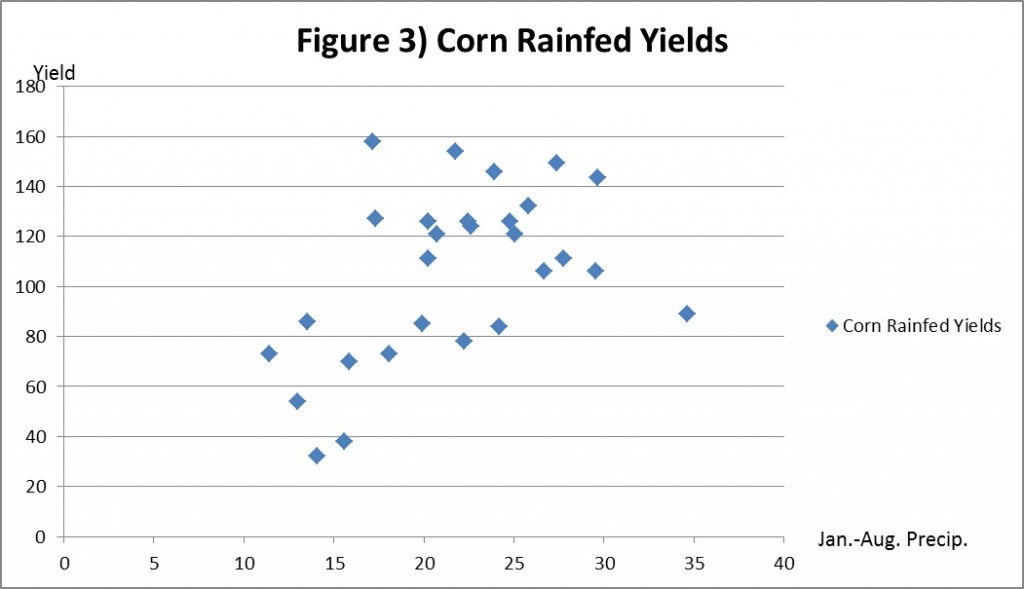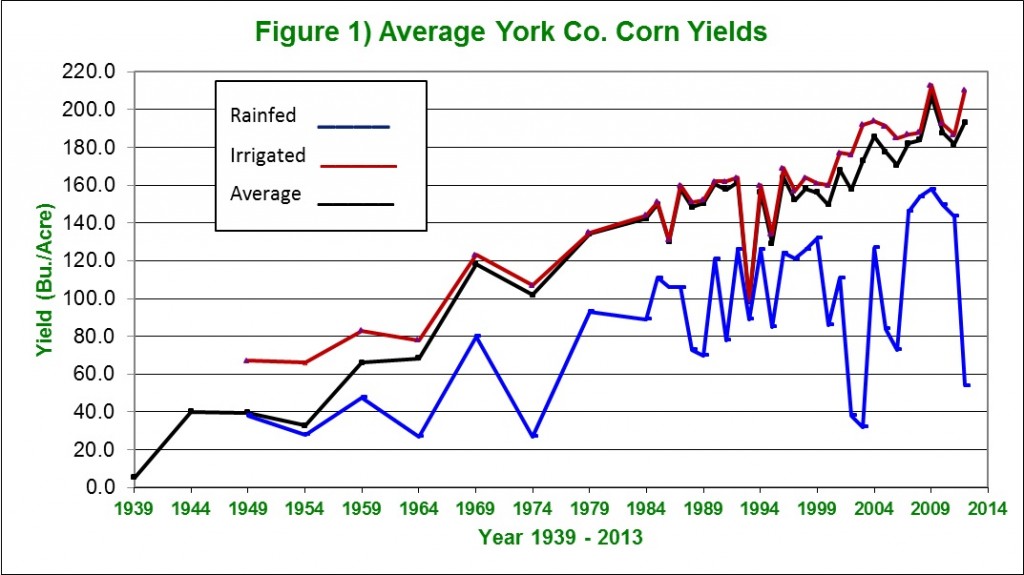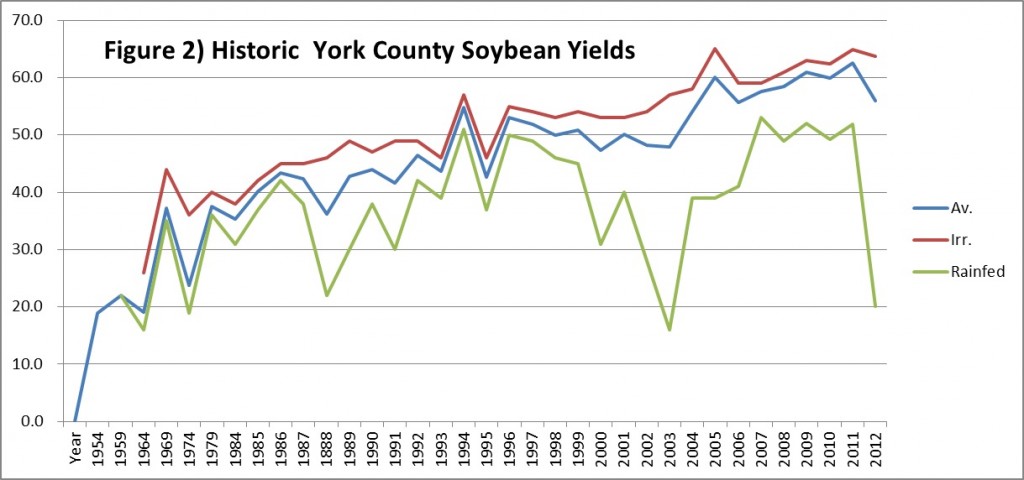Coming Events
- May 7 – Crop Scout Training, 9:00 a.m., ARDC, near Mead, to register, go to: http://ardc.unl.edu/cmdc.shtml
Cropping Update
We continue to have our typical, not-so-typical Nebraska weather. We’ve had several days of rainy weather, but have not received an excessive amount of rain for the week. The rains have been variable, and here in the York area, we’ve received 2.28†for the month, so we’re getting near our April average of 2.61†and our year-to-date total of 5.75â€. As I prepare my column today, it looks like we could get some rain/snow this afternoon and evening and then things clear up the rest of the week; we can sure use the moisture to continue to fill our profile, but I know producers are really wanting to get out and get some planting done. Saturday I went out and checked the moisture in the rainfed field that I’ve been monitoring and it is wet down to just short of 2’. I took a soil probe and I could get to about 20-22 inches, and then it was very hard and dry. I had hoped it was a little deeper than that, so we’ll need timely rains to get near normal trend line yields in our rainfed fields. Over the years I’ve been charting the York County NASS corn and soybean yields so I thought I’d share them (see Figures 1 & 2). Our irrigated yields have continued go up. Since 1949, irrigated corn yields have gone up on average by about 2.27 bu./acre/year while irrigated soybean yields have gone up by about .73 bu./acre/year since 1974. I’ve also plotted our rainfed yields compared to the January through August rainfall for the years since 1985 for both corn and soybeans (see figures 3 & 4.). Since 1985, our average precipitation from January through August has been about 21.5â€. When we receive that or above, we typically have some good rainfed yields, but we’re starting a little short of a full profile, so I guess like always we’ll have to wait to see what kind of year it will be.




I also want to remind producers to not be tempted to get out into the fields too soon and not to plant the seeds too shallow. Not too many good things occur if we get out too soon. Paul Jasa shared some great information in this week’s issue of CropWatch. With the later planting season this year, some producers may consider planting shallower to get the crop up quicker. Unfortunately, the corn roots may not develop properly when planting too shallow and the stands may not grow uniformly.  To develop a good root system and more consistent stands, we suggest planting corn 2 to 3 inches deep. Last year we saw considerably rootless corn because the corn was planted to shallow and the topsoil dried out. Check out the corn planting tips in this week’s issue of CropWatch at: http://cropwatch.unl.edu.
The soil temperatures continue to be cold compared to normal. I checked the CropWatch website and our average soil temperature for the York area averaged 41.9° F this past week compared to our normal average of 52.2° F at the 4†depth; that’s over 10° F below normal. It looks like that should change the next few days as things finally begin to warm up. That link to the UNL’s Crop Watch website is: http://cropwatch.unl.edu, then click on the weather link at the top of the page.
For the first three weeks of April of this year, our high temperatures have averaged 54° F and our low temperatures have averaged 29.9° F. That compares to 67.7° F and 40.9° F last season. I guess that’s Nebraska’s weather!
Crop Scout Training Course Planned
Last week I mentioned the Crop Scout Training Planned for May 7 at the ARDC. Topics will include: how corn and soybean plants grow and develop, soybean and corn insect management, identifying weeds – plant morphology, using a key to identify weed seedlings, crop diseases and quiz, and nutrient deficiencies.
Cost is $125. Fees include lunch, refreshment breaks, workshop materials and instruction manual. Registrants should preregister one week in advance to reserve their seat and to ensure workshop materials are available the day of the training session. Updated reference materials are included in this year’s take home instruction manual.
For more information or to register, contact the ARDC, CMDC Programs, 1071 County Road G, Ithaca, Neb., 68033, call 402-624-8000, fax 402-624-8010, or visit:Â http://ardc.unl.edu/cmdc.shtml.
Yard & Garden
Did you dormant seed any turfgrass this past fall or spring and are watching to see if it’s germinated? Many other people are too and this past week Zac Reicher, Professor, Turfgrass Science posted a little info to the Turf iNfo website. “Will seeds eventually germinate and seedlings develop? His answer was a resounding “Yes,†and germination is often seen when soil temperatures near the seed (surface) consistently rise to 50° F during the day.â€Â So hopefully we’ll see some starting to grow this next week or two.
FarmBill Webinars Planned
Tim Lemmons, Extension Educator shared information that the Ag Econ Farm Bill team is tentatively scheduling public webinar meetings for Monday, April 29, and Friday, May 3, from 10:30 a.m. to noon Central Time. This is to provide sufficient timing to advertise the program. I don’t have the website at this time, but should have it by the end of this week and will post it on our York County Website: http://york.unl.edu.
I’m guessing it will be: https://Connect.unl.edu/farmbill. It will be archived so if you’re out planting or not available, you’ll be able to view it at a later time.



































